David Meerman Scott's Blog, page 64
June 16, 2014
How Beko develops products global consumers are eager to buy
 Recently I delivered a talk at the Arcelik Global Brand Summit in Istanbul.
Recently I delivered a talk at the Arcelik Global Brand Summit in Istanbul.
Arcelik, based in Turkey, is one of the largest white goods (refrigerator, washer / dryer, dishwasher) manufacturers in the world. The company sells white goods and other electronic products in over 100 countries under many brand names with Beko as one of the best known around the world.
What fascinated me about Beko is that they do buyer persona research in many of the countries they sell in and modify product features based on what they learn from consumers.
They key here is that Beko staff develop buyer personas using actual input from interviews. Unlike most companies that dream up product features in a conference room at HQ, Beko taps the marketplace to gather intelligence first.
Consumer insight from the China market
 With clothes dryers, Beko marketing people learned through discussions with Chinese consumers that the traditional approach of drying clothing in the sun is an important aspect of Chinese culture. Therefore, Beko learned, it might be too much of a leap for consumers to go from hanging clothes to dry to drying indoors with a dryer.
With clothes dryers, Beko marketing people learned through discussions with Chinese consumers that the traditional approach of drying clothing in the sun is an important aspect of Chinese culture. Therefore, Beko learned, it might be too much of a leap for consumers to go from hanging clothes to dry to drying indoors with a dryer.
In particular, Beko learned that in some parts of China, people believe that clothing is part of an individual’s soul. After washing, the clothing must be exposed to sunlight in order to bring the soul back.
Seems like an insurmountable problem, doesn’t it? Not for Beko! They developed a dryer that includes a setting that stops the cycle after clothes are half dry. The consumer then hangs the slightly damp clothing outside in the sun to finish the process. These dryers are selling very well in China.
A setting for rice
 Another insight led to product development in the Beko refrigerator line sold in China. As rice is a staple of the Chinese diet, rice storage is important for Chinese families. It turns out that rice is best stored at low humidity at about 10 degrees Celsius. But this is not a good setting for storing fresh foods.
Another insight led to product development in the Beko refrigerator line sold in China. As rice is a staple of the Chinese diet, rice storage is important for Chinese families. It turns out that rice is best stored at low humidity at about 10 degrees Celsius. But this is not a good setting for storing fresh foods.
To solve for this insight gained through buyer persona research, Beko product engineers created a three-door fridge that has the usual freezer compartment, refrigerator compartment and a new third door that serves as a compartment for rice storage.
With both the fridge and the dryer, the buyer persona insights are also used to market the product. In particular, the actual words and phrases used by Chinese consumers to describe the way they dry clothing in the sun and how they store rice can be used in the content that Beko creates to describe the products.
At the 2013 IFA Fair, the world's leading trade show for consumer electronics and home appliances, this Beko refrigerator won a coveted innovation award.
You simply can’t make this stuff up in your conference room. The only way to learn about customer needs in a global marketplace is to spend time speaking with buyers in the countries you plan to sell to.
In a similar way to the product development aspects, marketing and advertising of the products also tap insights from buyers so that such assets as web content appeals to consumers in the China market.
In all markets, buyer persona research reveals insights that drive success.
June 12, 2014
Injecting humor into your product descriptions
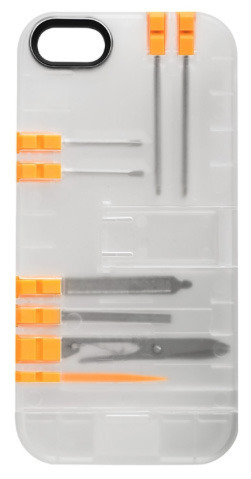 I just purchased an IN1 multi-tool utility case for my iPhone.
I just purchased an IN1 multi-tool utility case for my iPhone.
It’s a cool product that stores pens, screwdrivers, scissors and other small accessories into an iPhone case. Kind of like a Swiss Army Knife for your smartphone.
I wasn’t going to buy it because I thought for sure I couldn’t bring it onto an airplane.
The product description sold me because I loved the writing so much that I actually read down to the part about being TSA compliant.
"So whilst the in1 case won't assist you in removing and rebuilding a gearbox from a 1985 GMC Pacer or help you slay, skin and cook a wildebeest, they will help with day to day tasks such as writing notes and cutting open packages. Also by leaving the Cross Bow and Bowie Knife attachment off the in1 case it has allowed us to make it fully TSA Compliant.
Yes! Thats right the In1 case is also TSA compliant! Which means that you can plan a trip with your new lover without being scared of holding up the queue explaining that it isn’t a weapon, it is actually just a phone case (they might still be interested in its fantastic design though)."
Perfect for my lifestyle
A pen! An analog writing device on my iPhone case! Brilliant. I can use it to fill in customs forms when I travel. And the screwdrivers and scissors are perfect for small repairs in hotel rooms.
Injecting zest into your product descriptions
So many product descriptions are boring.
How can you learn from the good people at IN1 and talk about things like 1985 GMC Pacers or a wildebeest or new lovers when describing what your company has to offer!?
June 8, 2014
John Green thumps Tom Cruise
Tom Cruise was everywhere on television last week promoting his new mega-budget sci-fi spectacular Edge of Tomorrow which released this weekend.
Cruise deployed the tried and true method where the film’s star goes on the entertainment television shows and late night talk shows like The Tonight Show Starring Jimmy Fallon.
Cruise used old marketing and PR techniques to promote his big budget film.
The Fault in our Stars hits number one
 Meanwhile, The Fault in our Stars also released this weekend.
Meanwhile, The Fault in our Stars also released this weekend.
John Green, the author of the New York Times bestseller by the same title rallied his fans to become #TFIOS brand ambassadors. These #FaultFanatics talked up the film big time on social networks and they drove the small budget film to number one in the box office this weekend.
The Fault in our Stars generated an estimated $58 million at the box office (film budget $12 million), thumping the Edge of Tomorrow, which generated about $29 million (with a whopping $178 million budget).
Rallying fans
John Green fans who love The Fault in our Stars book drove the box office success.
Throughout the past year or so, Green has communicated to his fans as insiders, providing all sorts of details on the process of creating the film version of the book that they love.
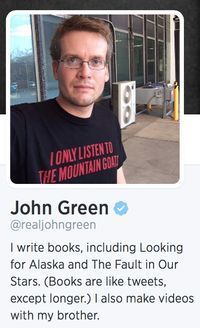 Green sold the film rights and told fans that he has no financial incentive in tickets sales. He’s talking up the movie because he likes it.
Green sold the film rights and told fans that he has no financial incentive in tickets sales. He’s talking up the movie because he likes it.
Through his Tumblr, @realjohngreen Twitter, video channel, and sites, Green has made fans feel a part of the process. The Fault in our Stars movie site is a fantastic place to explore and share.
Many John Green fans originated from the Vlogbrothers youtube channel that he co-creates with his brother, Hank.
My daughter Allison is a fan of John Green, the Vlogbrothers videos and Green’s books.
“I think a big thing is John acted like us, the fans, rather than a celebrity to promote the fandom involved in the movie,” Allison told me today. “People are encouraged to make art and music and responses to his book. Some of those he reblogged on tumblr and these also translate to the success of the movie. He is very open in communicating with his fans like they are his equals, which fosters community.”
Green talks about treating fans as equals in this video.
His video of the movie premiere is a great example of how Green brings fans along on the ride. In the video you are with him as he arrives, and walks the (not red) carpet, and mugs for photographers.
Lessons for your business
Rallying fans works for any business. When your better-funded competitors are focused on traditional marketing and PR, why not bypass them talk directly to your audience. You can thump the competition too.
June 7, 2014
The CIA Joins Twitter
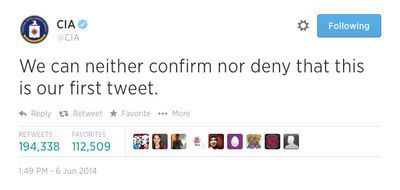 Ha! Now you will KNOW when they follow you. Well, on Twitter at least.
Ha! Now you will KNOW when they follow you. Well, on Twitter at least.
The @CIA joined Twitter yesterday. Yes, that CIA. They’re also on Facebook.
(I never thought I would write these words.)
In less than 24 hours, @CIA already over 300,000 followers.
The official CIA press release reveals: Follow us on Twitter @CIA and on Facebook for the latest CIA updates, #tbt (Throwback Thursday) photos, reflections on intelligence history, and fun facts from the CIA World Factbook. You’ll also receive updates on CIA career postings and get the latest glimpse into CIA’s Museum—the best museum most people never get to see. Our social media expansion will put CIA.gov content right at your fingertips.
On the CIA Facebook page, there's this wonderful description: "We are the Nation's first line of defense. We accomplish what others cannot accomplish and go where others cannot go."
 And when you click through the press release to go to one of the CIA social accounts, you get a fantastic popup. Love it. I wonder if you get the same warning after they've been snooping when they leave *your* site.
And when you click through the press release to go to one of the CIA social accounts, you get a fantastic popup. Love it. I wonder if you get the same warning after they've been snooping when they leave *your* site.
I’m glad to see this.
Anytime a big bureaucracy chooses to open up, even slightly, it is a good thing.
And the use of humor is welcome indeed. Nicely played, CIA pepole.
Let’s see what they do over the next months.
June 4, 2014
Video of my BMA keynote Marketing the Moon
Last week, I delivered the closing keynote at the Business Marketing Association 2014 annual conference, the largest business-to-business marketing conference in the world.
The talk was called Shooting for the Moon: What B2B Marketers Can Learn From the Marketing of the Moon.
While this talk was for a B2B audience, there are lessons for marketers of all stripes in Marketing the Moon, my new book (written with Rich Jurek) about the most successful marketing program in history.
How did space exploration, once the purview of rocket scientists, reach a larger audience than “Laugh-In”? Why did a government program whose SOP had been secrecy turn its greatest achievement into a communal experience? In my talk you will learn you can achieve audacious goals, too, using many of the same techniques that riveted the world 45 years ago.
June 2, 2014
Sales and Marketing Working Together
Web content drives both sales and marketing success.
But it is essential that we take just a little time to look at how the two functions differ. By making certain we understand the difference, we can close the gap between marketing and sales and grow business faster.
Marketing generates attention of the many people who make up a buyer persona, whereas sales communicates with one potential customer at a time, putting the buying process into context.
Reaching many people
It is the job of marketers to understand buyer personas—essentially groups of buyers—and communicate to these groups in a one-to-many approach. Marketers are experts at communicating to many people, and typically the potential customers they reach are not yet ready to have a sales discussion.
The marketing team captures the attention of a group of buyers and drives those people into and through the sales process. The content generated by the marketers—blogs, YouTube videos, infographics, e-books, webinars, and the like—can influence large numbers of people. Done well, with a deep understanding of buyer personas based on research, this content generates sales leads and culminates in the buying process.
Influencing one person at a time
The role of salespeople is completely different because they influence one buyer at a time when the buyers are much closer to making the buying decision. While marketers need to be experts in persuading an audience of many, salespeople excel in persuading the individual buyers. They add context to the company’s expertise, products, and services. Through them, the marketers’ content fulfills its potential at the precise moment the buyer needs it.
When the two functions work together, business grows!
May 29, 2014
Catching up and touching base
When I see an email with the subject line “catching up” or “touching base” I immediately categorize the email as somebody selfishly wanting something from me.
We haven’t spoken in a decade. You didn’t bother to make contact till now. But you’re looking for a new job so you want to “touch base”.
You didn’t bother to return my last email to you but now you want an introduction to somebody I know, so you want to “catch up”.
You’ve got to give to get
My grandmother told me that if you want to receive a letter, you have to write one first. Wise advice.
The more you give, the more you can ask.
Give to get applies in social networking as well. Be helpful and share. Good things will come back to you.
Think about what you can do for others. Give gifts. Write thank you notes. Make introductions. Connect people who should know one another. Review someone’s book. Suggest a job opening to a friend. Link to a blog. Re-Tweet. Like.
Say what you mean
There is nothing wrong with asking for a favor.
But use a descriptive email subject like: “I would like an introduction to Samantha” instead of saying: “touching base”.
Instead of “catching up” as your subject line, it’s fine to say: “I am looking for a new gig and would like your advice”.
May 28, 2014
Great content creation ideas come from seeing patterns
 As I write this I am in Istanbul, Turkey preparing for a speaking engagement later today. As I always do when I’m on the road, I’m looking for patterns that I might be able to use to create a blog post.
As I write this I am in Istanbul, Turkey preparing for a speaking engagement later today. As I always do when I’m on the road, I’m looking for patterns that I might be able to use to create a blog post.
Many people ask me about finding stuff to write about on their blogs. They know they shouldn’t just talk about their products and services but they struggle with what else to focus on.
Look around you! What’s interesting? How can you bring a hobby into your writing? What are your passions? What unusual places do you go or people do you meet? All can be used to create a blog post (or video or tweet or infographic).
My friend Larry and I were at the Nantucket Demolition Derby last fall and it turned into a perfect opportunity to post some content. Larry runs an insurance company, and the pattern he saw was that a demolition derby is the only time when an insurance agent enjoys a car crash!
Great content ideas come from finding patterns
I’m not sure what I’ll blog about here in Istanbul. As a travel geek, I certainly enjoyed crossing the Bosphorus Bridge from Europe to Asia yesterday. Is there a blog post in that somewhere? Probably. I just don't know where yet.
Here are several posts I’ve written as a result of just finding a pattern.
A post about the value of the people who work at a company: Your employees as a terrific marketing asset. I was in northern Finland, above the Arctic Circle and I came upon the perfect photo opp.
A post about how to find the time to blog and participate in social networking: Social selling means making a lifestyle change. The pattern I see is that developing an exercise routine is similar to developing a social networking routine.
A post about the importance of online communications in today’s world: Communications revolution. I see similarities to today and the sweeping changes resulting from the invention of movable type printing nearly 600 years ago.
A post about the many ways to compete in a marketplace: Market competition and your business. This post is based on an idea sparked while visiting the marketplaces in and near Marrakech.
Keep your mind open to the content creation ideas all around you.
May 23, 2014
Social selling means making a lifestyle change
 Making social networking part of your selling strategy requires making a change in your life.
Making social networking part of your selling strategy requires making a change in your life.
But it’s scary to make a lifestyle change. I know that. I did it two years ago myself.
It means a different routine. It means you need to find time. It means you will be out of your comfort zone (at first).
Over the years, I’ve interacted with thousands of people who want to begin creating content on the web for sales purposes. I’ve discussed how to get active on social networks like Twitter, Instagram, Facebook and the like to reach buyers directly and at the moment they are interested.
Social selling means making a lifestyle change
The advice I give to someone who, say, wants to start a blog to reach buyers and sell more is they need to make a lifestyle change. You can’t just dabble here and there. You need to be consistent and update the blog a few times a week because each post is a real-time update of your expertise and every one is a link that search engines will find and index.
So how do you find the time to create several blog posts (or YouTube videos if you don’t like to write) a week? Simple! You make it an important part of your life.
I recommend that you don’t even try to find the time to create content and participate in social networks. You’ll fail, just like finding the time to exercise leads to failure and wasted money on health club memberships.
Many people are surprised when I say that I probably spend about six hours a week on social networking—about the same amount of time I spend exercising each week. I don’t even think about it. It’s important, so I do it. And I can’t really say how. It’s mainly in microbursts of one or five minutes throughout the day.
Exercising and getting fit
I’ve found that finding the time to participate in social media is much like exercise; you need to make it an important part of your life. If it is important to you, you don’t even think about it anymore. It just is.
Two years ago today, I started the P90X fitness program, a series of videos starring Tony Horton. I’ve “graduated” from all three of the 3-month routines: P90X, P90X2, and P90X3.
The P90X program focuses on “muscle confusion” a fitness philosophy of mixing up routines. The idea is that while running every day of the week is good, doing seven different things during the seven days of the week is better.
I now do a modified P90X. Most weeks I’ll do a day of gravity routines including push-ups and pull-ups, a day of core work such as Pilates, Yoga a day a week, a day of swimming, Dumbbell work another day, some lower body stuff another, and if I’m near a beach or trail I’ll go for a run or a mountain bike ride.
I hit all the muscle groups and never allow my body to become accustomed to the same exercise.
My fitness level has increased significantly.
I’ve gone from being able to do 2 chin-ups two years ago to 15 chin-ups in one go today. I even do some crazy stuff like pull-up-crunches and 4-medicine-ball-push-ups. Today, at age 53, I am more fit than ever before. I’m stronger than when I was a teenager and have much more endurance than when I was in my 20s.
You have a choice
You can choose to exercise regularly in order to stay fit. The most effective way is when exercise becomes part of your routine.
You have the same choice with implementing social selling. Make it a part of your life and you’ll succeed.
May 22, 2014
Signed limited edition copies of Marketing the Moon
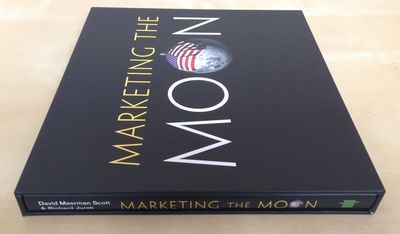 Just in time for Fathers Day (or a very early start on Mothers Day 2015), I’m offering a special limited-quantity boxed special edition of Marketing the Moon signed by Gene Cernan, the last man to walk on the moon who wrote the foreword to the book as well as signed by my co-author Rich Jurek and I. See below for details.
Just in time for Fathers Day (or a very early start on Mothers Day 2015), I’m offering a special limited-quantity boxed special edition of Marketing the Moon signed by Gene Cernan, the last man to walk on the moon who wrote the foreword to the book as well as signed by my co-author Rich Jurek and I. See below for details.
Getting Buzz
Marketing the Moon has been out several months now and has gotten some great buzz including from Buzz himself – Aldrin that is, who spent an hour with us several weeks ago discussing it.
We scored a coveted “one sentence review” in the Sunday New York Times (“U.S. government goes ‘Mad Men’ on Apollo, gets it right”), a half page write-up & photo in the Wall Street Journal, several NPR radio interviews, and many print and online reviews. Thank you to those who blogged it, tweeted, or posted online reviews!
This week, Hans Rollman wrote in PopMatters: “it’s a book for the coffee table, the office desk and the lobby.” That's what we like to hear, our art is suitable for display.
One of the coolest parts of this project has been working closely with many Apollo astronauts. We’ve interviewed or spoken with more than half of the humans who walked on the moon as part of this project.
Signed, boxed, limited edition
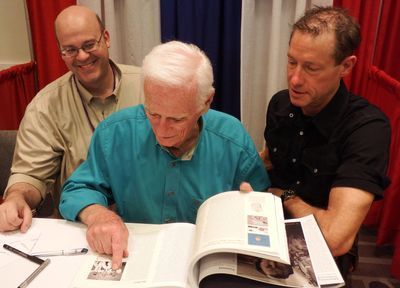 Rich and I produced a very special edition of the book. Only 100 copies were produced, with many already given away. The books include a beautiful slipcase and custom outer box. Best of all, they are signed by Apollo moonwalker Gene Cernan, Commander of Apollo 17 and the last man to walk on the moon. In this photo, Rich and I are discussing the book with Gene.
Rich and I produced a very special edition of the book. Only 100 copies were produced, with many already given away. The books include a beautiful slipcase and custom outer box. Best of all, they are signed by Apollo moonwalker Gene Cernan, Commander of Apollo 17 and the last man to walk on the moon. In this photo, Rich and I are discussing the book with Gene.
Makes a great Father's Day gift!
Rich and I spent a great deal of money on this special edition. It is our art and we are not making profit from the project.
We’re offering them at $295 each, which includes USPS priority shipping in the USA. If you are outside the US, please email me for the cost to ship to you. We can take PayPal or a credit card.
Please email me right away at david@freshspot.com if you want to grab one while we have some left.




